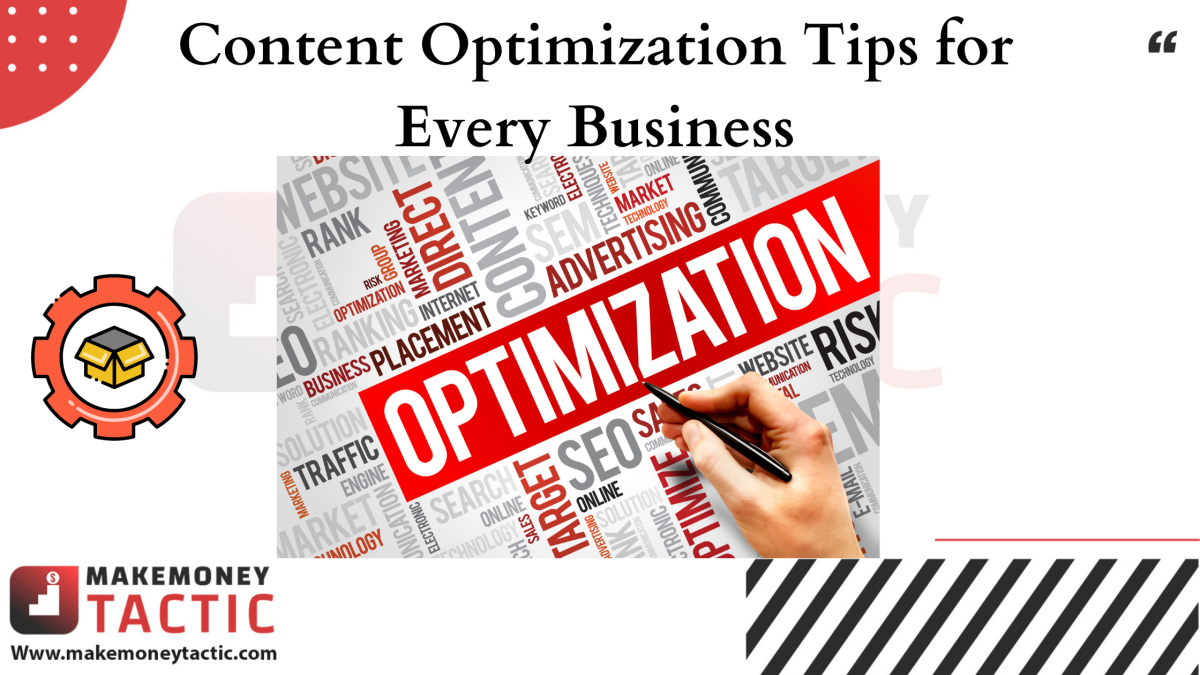Content optimization is one of the steps that cannot be ignored if you want your website to become user-friendly and search engine friendly. You need to know the following content optimization tips to achieve high rankings and increase traffic and conversions.
Why is content optimization important?
Content optimization is transforming the content on a website to become more attractive and helpful to users and help increase conversion rates. The main goal of content optimization is to make the content as valuable to the user as possible. When users feel satisfied, Google will rank your page high.

Impressing users means making an impression on search engines. Doing so, you’re helping Google better understand your content and make it easier to crawl your business. These Content optimization tips will help.
Google rankings will determine traffic and the ability to convert into customers. If you create ineffective content, you will have difficulty convincing users and search engines. By creating quality content (e.g., blog posts providing in-depth knowledge), you are investing in a long-term traffic attraction campaign, helping to increase your ability to rank higher than your competitors.
Difference between content optimization and search engine optimization
SEO-er understands that keywords (keywords) are phrases or queries that your target customers use to search. However, Google gradually no longer depends on keywords, culminating in the appearance of the Hummingbird algorithm, increasing the importance of natural language queries and focusing on context and meaning instead of individual keywords.
This means you need to mine the topic close to the semantics of the users’ phrases. Content optimization helps to give the most detailed and meaningful answers to search queries. When your content touches on relevant topics and issues, you increase your authority in your field and improve rankings.
For example, when you write about “digital marketing,” the content in the article should have related phrases such as SEO, social media, advertising, etc. Focus less on keyword density and focus on deep mining of the topic. From many angles is an indication that you are an expert on the subject.
Content optimization tips: 3 common mistakes when optimizing content
If the content doesn’t meet the audience’s expectations, leaving them with a wrong impression, they will go immediately. The result is a high bounce rate. Here are 3 of the common content writing mistakes that you should avoid.
1- THE CONTENT IS NOT OUTSTANDING
When users Google something, they usually click on the first three pages or sometimes all of the first page’s results. Users will rate your content as unremarkable and worth reading and sharing with others if your content doesn’t provide real value.
Therefore, to capture users’ interest, you need to find topics your target audience is interested in or even ideas and questions they haven’t thought of. “Answer The Public” and “People Also Ask” are suggestions for questions and ideas for you to implement content.

In addition, remember that creating content is similar to selling a product. You must find its unique selling point to attract target customers successfully.
2- AMBIGUOUS TITLE
The title is the first thing users notice. If it’s too general or doesn’t make sense, you’re smothering your chances of getting users to click through. They are fed up with generic content. If your title isn’t unique, they won’t bother clicking.
For exciting and detailed headlines, try to find a unique selling point in the content. It will be easier to make headlines, and users will have a compelling reason to read and share your content with many others.
3- DIDN’T EDIT CAREFULLY WHEN POSTING
Articles published when they are just raw and unedited will give customers a wrong impression of your unprofessionalism. Your goal is to convey the right message through the content, but if the content has many errors, it will reduce its value in readers’ eyes. What you need to do when editing is to limit typographical mistakes, make sure to use the correct words, and express the meaning clearly.
✅See also: How To Write Content for Website Using Jasper AI
Content optimization tips to increase traffic
1- Use right keywords
Along with writing quality content, you also need to pay attention to keywords. Using it properly will help you rank for certain keywords. Make a list of important keywords and put them in the right places. Suggestions are as follows:
2- Use attractive page title
Placing the main keyword at the beginning of the title will help to rank higher. The title should contain between 30-60 characters.

3- Add compelling meta description
Meta descriptions are the lines that appear under the page title on the search results page. This is where you should insert important keywords, help stand out from other results, and increase the click-through rate.

4- Use keywords in body
Inserting the primary keyword in the body of the article, especially in the first paragraph, will make a difference in rankings.
5- Add inbound links
Add inbound links from other relevant pages on your site to the page you want, using the right keyword for the anchor text.
6- Optimiza pages
Insert important keywords into the alt tag and file name caption. Avoid stuffing too many keywords.
7- Improve organic CTR with snippets
Low organic CTR will adversely affect your SEO and ROI. So how to increase CTR naturally?
Pay attention to the length and keywords in the title and meta description. Make your call-to-action engaging.
Using featured snippets, Google will use your content as a direct answer to a specific query.

– Use structured markup (e.g., review) to create a prominent advantage over other competitors.
8- Update old content
Rewriting, updating content, and linking is part of content optimization, helping you still bring value to users without writing new content. Following trends and updating content to reflect trends is a must.
9- Keep your writing SEO-friendly
Creating easy-to-read content is the most essential step to enhancing user experience. No one wants to scroll through an article that is packed with text and has no images. All you need to do is make the content easy to see before they spend time reading and converting later.
Here are some tips to help improve the user experience:
Use line structure, and short paragraphs with lots of white space, making it easier for readers to see and absorb the content.
Use subheadings to make it easier for users to browse for the information they need.
– Add images and videos, increase vividness, and reduce boredom.
– Optimized for mobile interface.
✅See also: How to Drive Traffic to Your Website: Learn the 33 Free Methods
Content optimization tips: 3 IMPORTANT FACTORS WHEN OPTIMIZING CONTENT
1- RELEVANCE
Content optimization is only effective when your chosen topic is relevant to your target audience. A blog post can meet all the criteria for on-page and off-page SEO but will fail in terms of backlinks or social shares if readers are not interested in the content.
To create the right content, you must first understand your audience and build customer personas based on that understanding. Your content will then be both relevant and valuable.

2- POSTING FREQUENCY
Each market will react differently to content. That’s why posting frequency should be based on the target audience. Some businesses still deliver value that users are satisfied with even if they only post one post/week, while other brands will need 3-4 posts/week. To determine the right frequency, you must take time to experiment gradually.
3- POSSIBILITY
Every piece of content you create needs to give your readers useful, detailed, and share-worthy information, be it a blog post, case study, video, etc. The content format can vary, but the level of usefulness must be high, and there should be a factor that makes the user “wow.”




